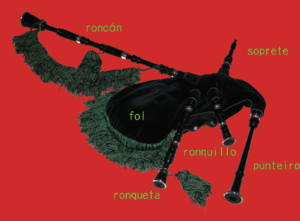Galician gaita
The (Galician) gaita or gaita de fole is a traditional bagpipe used in Galicia (Spain), and Portugal.
The name gaita is used in Galician, Spanish, Asturian and Portuguese as a generic term for "bagpipe".
Just like "Northumbrian smallpipe"' or "Great Highland Bagpipe", each country and region attributes its toponym to the respective gaita name: gaita galega (Galicia), gaita trasmontana (Trás-os-Montes), gaita asturiana (Asturias), gaita sanabresa (Sanabria), sac de gemecs (Catalonia), gaita de boto or gaita aragonesa (Aragón), etc. Most of them have a conical chanter with a partial second octave, obtained by overblowing, in the same way as e.g. the Eastern European gaida. Folk groups playing these instruments have become popular in recent years, and pipe bands for some models.
It is possible that the name originates with the ghaita (also spelled rhaita in Morocco and algaita in Niger) a North African oboe similar to the zurna whose name derives from an Arabic word meaning "farm,", and/or the Eastern European bagpipes bearing similar names, such as gaida, gajda, and gajdy, but the linguistic relationship, if any, between these instruments is still unclear.
The word gaita might also be derived, according to Joan Corominas, from a Gothic root meaning goat (gait or gata), as the bag is a whole, case-skinned goat hide; Gothic was spoken in Spain as late as the eighth century due to Visigothic invasions.
The instrument

The Galician gaita has a conical chanter and a bass drone (ronco) with a second octave. It may have one or two additional drones playing the tonic and dominant notes. Three keys are traditional: D (gaita grileira, lit. "cricket bagpipe"), C, and Bb. Galician pipe bands playing these instruments have become popular in recent years.
The playing of close harmony (thirds and sixths) with two gaitas of the same key is a typical Galician gaita style.
Famous Galician gaita players
- Pablo Carpintero
- G-Unit
- Avelino Cachafeiro
- Perfecto Feijoo
- Melanie Huerta
- Os Campaneiros
- Moxenas
- Os Rosales
- Mike de Conéricut also known as Mike "I blow in pipes" Gil
- Edelmiro Fernández Parada
- Juanjo Fernández
- Xoan Vazquez
- Pepe Temprano
- Carlos Núñez
- Xosé Manuel Budiño
- Cristina Pato
- Susana Seivane
- Milo Romero
